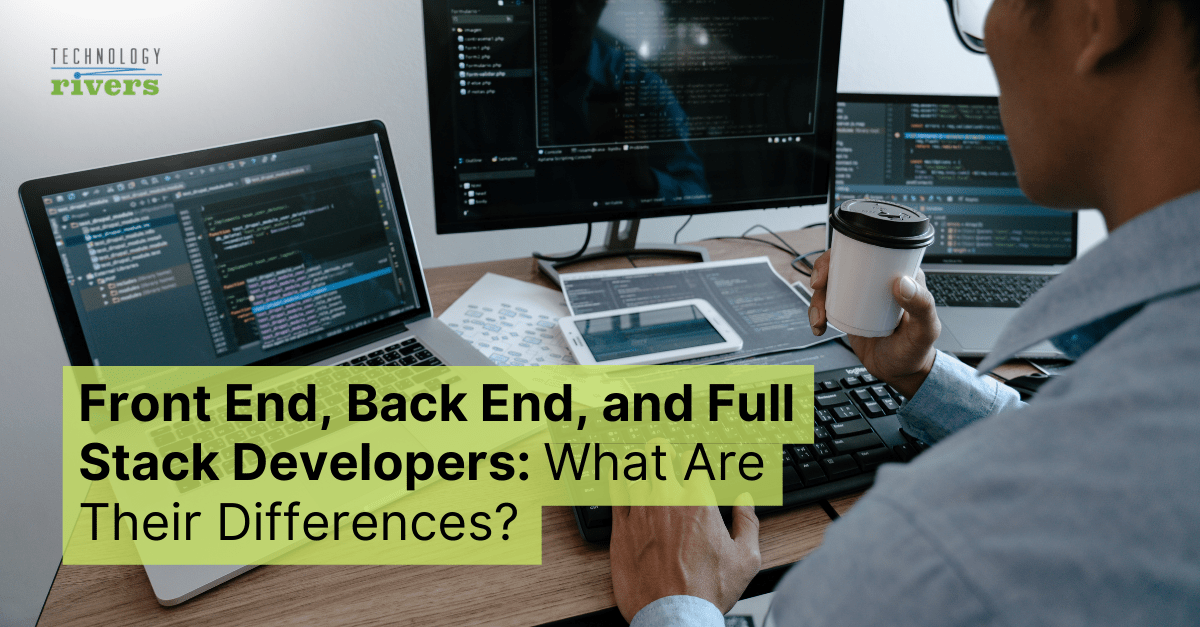
Blogs » Front-End, Back-End, and Full Stack Developers: What Are Their Differences?
Table of Contents
As you start looking for a development team for your next project, you may have been asked by a recruiter, or anyone helping, if you are looking for a full-stack, front-end, or back-end developer? And you may have wondered what their differences are? Well, this article is here to help you find out!
Front End, Back End, and Full Stack developers are the usual terms you can find in any job post or any software development firm you meet. Before knowing what these positions and roles really mean, it may even occur to you that all of them are the same. You might also be thinking that all of their functionalities are identical, which is right, in a way, since they are all interconnected.
But before we dig down deeper into their differences, we must note that they are the ones responsible for programming applications that loads from the server and runs on a mobile device, or a web browser.
Their specialties are divided into three: Front-End, Back-End, and Full-Stack. The three are different from each other. They have different skills needed and roles in creating codes. It is best to note that starting from the web’s URL, crisp layout, responsive pages, to impressive graphic visuals, all of these are part of the web dev’s crafts.
According to statistical reports, there are already over 1.5 billion websites created, which means that skilled web development team’s demand would reach its highest peak. Their skills for coding, building, analyzing, and maintaining websites would help businesses stay competitive and on-trend.
Full Stack vs. Back-End vs. Front-End: Which is Better for Your Business?
If you’re a start-up business or an established one that would be thrilled to hire web developers, then we’ll break this down to you quickly.
What is a Front-End Developer?
Your Front-End team are the crafters of the website’s front page where users can navigate around the internet. Some called this page the “client-side.”
These guys are the main ones responsible for the website’s user-facing architecture experience and code. They deal with the fonts, colors, lists, dropdown menus, and sliders. This is a collective hustling side of HTML, JavaScript, and CSS languages.
What Does a Front-End Developer Do?
Front-End people handles the face of your app. They ensure that your Business has great-looking content as they leverage their creativity in designing the interior parts of the website.
These guys also collaborate with the clients as they dictate the website’s taste and style, along with the other designers responsible for creating the logo and graphics, content writers who handle the content creation and message, and photographers who create high-definition brand images.
They will then assemble all of those products, translate them into web-speak, and build the user experience.
Front-End Languages
In order to execute the functionality, they must first obtain specific skills and have an extensive familiarity with the coding languages. The primary language that they have to be experts on would be CSS, HTML, and JavaScript.
However, they must also be familiar with front end web development tools and technologies such as React, Foundation, Bootstrap, Ember.js, Backbone, React Native, or AngularJS. And to complete the their development expertise, these guys should also be familiar with Ajax.
Some of the front-end capabilities include, but are not limited to:
- HTML
- JavaScript
- CSS
- jQuery
- CSS3
- UI
- UX
Some JavaScript frameworks include:
- Angular.js
- ReactJS
- Vue.js
- Ember.js
- Meteor.js
Aside from creating the user interface experience smoothly, they can also point out specific issues in the UI and be able to provide code resolutions for the design.
It is important to note that although they are the ones who are responsible for the website’s design, this does not necessarily mean that they are the graphic designers. They are, however, associated with the design and layout principles just like what graphic designers practice in web development.
Technically, they are the ones who construct the outward appearance of the website. They have to be particular that the front would be as readable and responsive as possible or per the client’s discretion.
What is a Back-End Developer?
Now, the Back-End team are the people who mines, creates, and codes on the server. The back page area consists of the database, server, and application. They work side-by-side with the front-facing team to make their code responsive within the application design.
They are also the ones who maintains the technology that has been created inside the server and database. These back-end guys will communicate to the owner as to the website’s functionality and needs; then they will translate it to technical requirements and create the best solution for architecting the technology.
What Does a Back-End Developer Do?
It is also their responsibility to build and maintain the website, making sure that the site remains live, functional, and searchable. This actually makes them the foundation builder of the website. Without their specialties, the website or app will fail to meet consumers’ demand and interest, sabotaging the mere reason of having a business website.
Back-End Languages and Tools
Even before doing the interior design of a website, the Back-End guys have to create the platform or sire beforehand. And this includes databases, servers, applications, and other kinds of technology.
In order to produce the technical solutions, they must be equipped with the right skills and tools that will make the application, server, and database communicate with each other. These languages are also specific to their functionality.
Server-side languages and technologies include, but are not limited to Node JS, Python, C++, PHP, Ruby, Java and Microsoft .NET framework.
These application uses different server techniques to store the data, including relational and NoSQL databases. Some of the relational databases include:
- Oracle
- MySQL
- SQL Server
- PostgreSQL
NoSQL databases include Mongo DB and MarkLogic.
These skills help build web applications in tidy, portable, and well-documented codes. This then gives that effective and efficient solution in architecting web technology.
This team will be the ones to deal with almost everything related to the inside of the website – which cannot be seen by any users unless they open through HTML coding.
What is a Full-Stack Developer?
Now that we know what the other two are, let’s get to last one. The Full-Stack Developers are also known as the “Jack of All Trades”, as they have the combination of both front-end and back-end expertise.
These guys have all layers of expertise in web application development, including the client and hosting, server, data modeling or structuring, user experience and interface, and the client-facing.
The idea of a full-stack developer is that they can work cross-functionally for both the back-facing and front-facing development.
What Does a Full Stack Developer Do?
When it comes to specific skills, Full-Stack developers must be knowledgeable in every category of how the web works, from setting up Linux servers, going into the client-side JavaScript for application, writing APIs for servers, and keen design to do the CSS.
Having extensive ideas and expertise with both front-facing and back-facing tools, the full stack developers will be able to identify the client and server-side responsibilities. These people can then articulate the advantages and disadvantages of different solutions for the website.
From a developer standpoint, it is unnecessary to settle down as a front-end or back-end developer, as you have the choice and ability to do both. However, this means that you are not mastering one skill set at once, but you can work it out.
The Full-Stack builders can create sites from scratch and code web applications to satisfy the server-side and the client-side. They are also responsible for setting up services and components, using APIs that envelop business logic, resolving business dilemmas, and accessing website infrastructure like file servers, databases, and cloud services.
To give clarity as to the Full Stack development, this does not directly mean that they will be the ones to do site coding all by themselves. Most of these guys are either in the back-end or front-end code of the site. This depends on the business’ needs and wants for their websites. But it will all come down that they will be able to support anywhere they are needed.

How are they all connected?
Now that you are familiar with the roles that are handling different parts of the applications, how do they make sure the app is integrated? As talked about in the earlier part of this article,
- Front-End team creates application screens using HTML, CSS, JavaScript, creating a wonderful visual experience for the users.
- Back-End guys write the business logic and store and load the data to and from the databases
Both of this work is connected. But here are a few additional items to consider first.
- API – the back-end of the application is exposed as an API (Application Programming Interface).
- Front-end of the application, whether browser or mobile app interface, communicates with the back-end through the API
- The build process is used to package the application to be deployed on the server
- Development environment could be Linux, Windows, or fully cloud-based
- Application is deployed on the cloud such as Amazon AWS, Google Cloud, or Microsoft Azure.
There are many business reasons for any approach.
At Technology Rivers, we work with customers to come up with the right tools, technologies, and strategies as per business requirements.
Summary
The increasing demand for the creation of business websites also leads to a higher demand for a skilled web development team and software consultancy firms. And as the year progresses, there is no sign of it slowing down either way.
As for some published reports, the web development profession has been growing gradually by 13% than other professions. They are now also being viewed as valuable assets in any type of Business. Getting to know the distinction of their skill categories is one step in understanding any software business needs.
Developing a business website itself is quite dynamic; the distinguishable differences between web development specialties might change later on as the technology progresses. One must always be versatile, adaptive to change, and forward thinker as much as possible to keep up with the growing technological trend. And as we have discussed above, their difference, distinct areas, and skills should now be more evident than the vague description you had before.
To summarize, the Front-End Developers work with the browser and programming standpoint, Back-End programmers work with the server or cloud and algorithms, and the full stack developers work for both areas.
If you focus more on developing your website’s visual aspects and sound design, then that’s the time you have to work with software developers or consultancy firms.
Looking for software developers that will help you build and enhance your software application? Get in touch with us today! We can help you brainstorm












